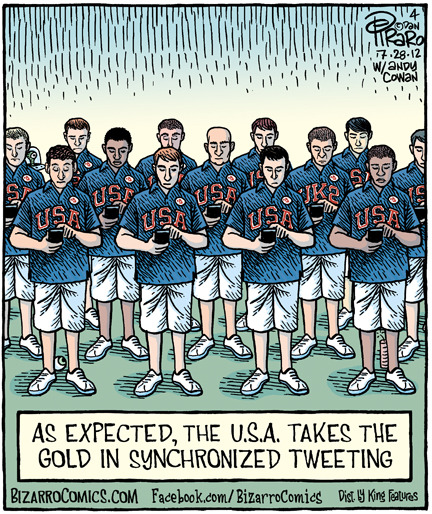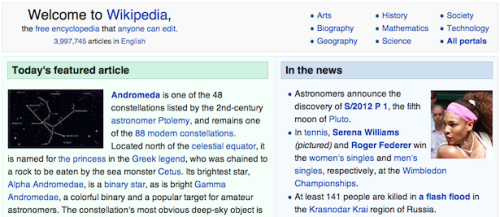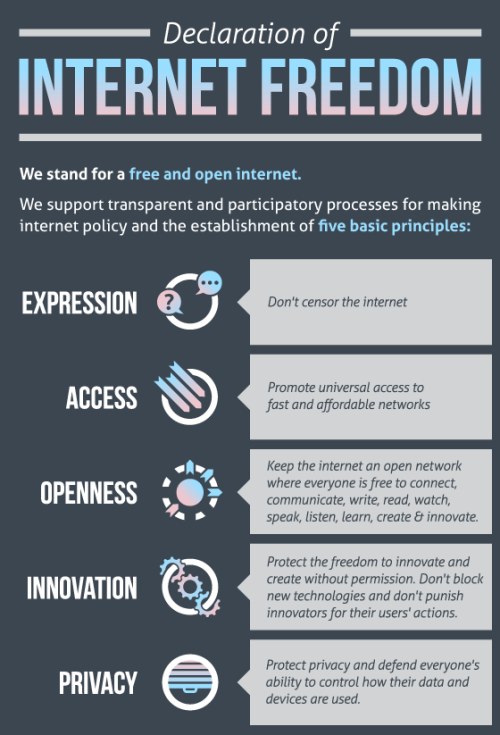
The newest Olymic sport, Synchronized Tweeting, envisioned by Dan Piraro of Bizarro
China-based Zhu Jingxuan, a student from Donghua University’s Fashion & Art Design Institute, has created a concept device that captures pictures and aromas of food and prints them on postcards.
The ‘food printer’ is a combination of a camera, a smell extractor and a printer: the camera takes the picture of the food; while the smell extractor collects the aroma of it simultaneously; and the printer prints a postcard with aroma ink.
“Psychologists know that “secure attachments”—close, positive relationships such as healthy marriages and good friendships—increase our interest in new experiences. Babies who have learned they can count on their moms, for example, tend to try unfamiliar toys in a lab more readily than do babies whose insecure attachment to caregivers makes them anxious and clingy. A recent set of studies published in Personality and Social Psychology Bulletin reveals a surprising explanation for this attachment-exploration link: feeling alive and full of energy.
Research participants who recalled a close positive relationship from their lives were later more willing to opt for novel activities like foreign travel—and to report heightened vitality—than participants who had thought about a negative relationship or even a sitcom character. “In insecure relationships, people have to resolve negative emotions because their needs haven’t been met, and having to do that can be emotionally draining,” explains lead author Michelle Luke of the University of Southampton in England.
That energy drain leaves you with low vitality; exploring unfamiliar territory feels like it would be overwhelming. Thinking about a good relationship, on the other hand, may give you an energy boost for trying new things.”
Nearly 50% of U.K. parents say they now read books to their kids on e-readers or tablets or allow them to read on them, according to a survey carried out by Ipsos Mori…. one-in-four parents polled said they’d also bought their children an e-reader.
Tech-savvy younger children are adapting to e-books even faster than their older siblings, e-publishers say. Children aged 7 to 12 think of e-books like toys and find them “fun and cool,” while teenagers are more interested in print versions, according to a recent survey of 1,000 tweens and 1,000 teenagers by Bowker Market Research. That age group has never known a world without e-books, says A.J. McDonald, a spokesman for e-publisher Lulu. “They are raised in an environment with computers, phones, and iPads,” he says.
— Half of Bedtime Stories Now Read on E-Books
Even as this Scandinavian country, like other nations across Europe, bows to pressure from big media concerns to stop file sharing, a Swedish government agency this year registered as a bona fide religion a church whose central dogma is that file sharing is sacred.
“For me it is a kind of believing in deeper values than worldly values,” said Isak Gerson, a philosophy student at Uppsala University who helped found the church in 2010 and bears the title chief missionary. “You have it in your backbone.”
Kopimism — the name comes from a Swedish spelling of the words “copy me” — claims more than 8,000 faithful who have signed up on the church’s Web site.
It has applied for the right to perform marriages and to receive subsidies awarded to religious organizations by the state, and it has bid, thus far unsuccessfully, to buy a church building, even though most church activities are conducted online.
— In Sweden, Taking File Sharing to Heart. And to Church.
Digital is bringing people into conversations within the museum who would never normally be involved in the care of traditional physical objects. The IT department has never had to think of its servers as an extension of the museum’s photography store or general object store before… The server has become the latest museum site in addition to the physical building.
— How can museums preserve our digital heritage?
The Super Kamiokande (Kamioka Neutrino Detection Experiment) is a neutrino observatory located under Mount Kamioka in Japan. It is designed to observe solar and atmospheric neutrinos, neutrinos from supernovae, and aims to search for proton decay. It is a cylindrical structure measuring about 40 m tall and 40 m across, is covered in over 11,000 photomultiplier tubes (PMTs), and filled with 50,000 tons of pure water.
That’s the value of the time invested in the average Gmail account, given how many emails the average Gmail user has written (5,768), how long it takes to write the average email (one minute, 43 seconds), and the most recent U.S. Depart of Labor statistics on average annual salary ($45,230). In other words, if the average Gmail user were paid to recreate all the Gmail messages he or she’s ever written, it would cost $3,588.85. It increases by about $1,196 per year .You “spend” as much in Gmail every year as you do on your car. Your Gmail is worth five times as much as your laptop. Your Gmail represents over four weeks of wages. You store one old-school floppy disk (1.44 MB) of Gmail data every day
New evidence from Ohio State University found that a dim light at night — whether it comes from a night-light, or staying up late in front of a computer or TV — may be making you depressed.Source: The Week
Artificial light disrupts our natural circadian rhythms, which may in turn alter the body’s hormone levels. “When people spend too little time in darkness, it seems that the body suppresses release of the hormone melatonin,” says Laura Blue at TIME, which is thought to fight a myriad of conditions, including tumor growth and cancers. According to the American Medical Association, interrupting the body’s circadian rhythm could also lead to obesity, diabetes, and reproductive problems.
The team speculates that artificial light may be part of the reason depression rates have soared in recent decades. There is good news, however: When the afflicted hamsters were again allowed to sleep a full eight hours per night in the dark, their depressive symptoms disappeared completely. This offers gloomy night owls some hope, says Bedrosian. “People who stay up late in front of the television and computer may be able to undo some of the harmful effects just by going back to a regular light-dark cycle and minimizing their exposure to artificial light.”
“Gun enthusiast “HaveBlue” has documented in a blog post (via the AR15 forums) the process of what appears to be the first test firing of a firearm made with a 3D printer, The Next Web reports. Actually,. the only printed part of the gun was the lower receiver. But, according to the American Gun Control Act, the receiver is what counts as the firearm. HaveBlue reportedly used a Stratasys 3D printer to craft the part, assembled it as a .22 pistol and fired more than 200 rounds with it.”Source: KurzweilAI
“Called the RP-VITA, the robot uses an iPad as the primary user interface for doctors to remotely diagnose and treat hospital patients. Its makers hope the simpler operation will broaden the use of robots for telemedicine, similar to how the graphical user interface turbo-charged personal computer use.Source: Technology Review
InTouch Health’s specialty is remote-controlled robots for critical care, enabling people to be seen by doctors sooner than if they had to be in the same physical space as the physician. Getting a stroke victim, for example, to a specialist within three hours for diagnosis and treatment can make a huge difference to the patient. Similarly, specialists can provide care in intensive care units without having to physically be present, which should lower health care costs and improve care.”

Crystal radio technology has been around for many years. This “bottle radio” take on a crystal radio requires no power source, operates on the power from radio waves, and receives signal from a long wire antenna. As radio stations slowly move away from the AM band, the “window of opportunity” to experience this remarkable technology is dwindling. The “crystal” in question is contained inside a germanium diode, and is used to rectify the radio signal so that our ears can hear it.
On a past Apple conference call, Tim Cook said "one thing we'll make sure is that we don't leave a price umbrella for people". What's that? A price umbrella is when a company with dominant market share maintains high prices, leaving an opening for new competitors to enter at lower price points. In the case of the iPad, the price umbrella until recently was at $499. Someone could enter that market at lower prices and exhibit classic disruption to push them out from the bottom up.Source: iamconcise
Apple has already solved this problem twice, with the iPod and iPhone. So let's look at what they did.
Craigslist Joe is a documentary film produced by Zach Galifianakis that follows filmmaker Joseph Garner for 31 days & nights as he tries to find everything he needs off of Craigslist. Here’s the official trailer. It opens in theaters on August 2, 2012.

"Valve recently launched a free initiative called Teach With Portals that aims to help teachers use the game Portal 2 (click here for a review) to engage students in learning STEM and critical thinking. By converting its level-building software, Hammer Editor, into a much easier to use interface called Puzzle Maker, Valve has made it possible for anyone to design challenging Portal rooms. The Teach With Portals website also offers community-submitted lesson plans (here’s an example of a harmonic oscillator) that utilize the game and align with national STEM standards so teachers can directly incorporate them into their curriculum. Teachers can sign up for the ‘Steam for Schools‘ beta program, which offers a limited version of the popular Steam gaming platform that hosts the free version of Portal 2 and the Puzzle Maker.

Windows 8, the most radical redesign of Microsoft’s flagship operating system, is often said to be schizophrenic. On the one hand, the user interface that first greets users is beautiful: a fun, playful grid of colorful tiles, based on Microsoft’s well-received Metro design language, that offers access to apps and content. On the other hand, hidden beneath this Metro-enhanced surface is the same desktop-based UI we’ve known for decades, still riddled with taskbars, toolbars, and drop-down menus.Source: FastCoDesign
Today, Microsoft unveiled a preview of its latest version of Office, and like Windows 8, the newest iterations of Word, Excel, and PowerPoint are just as split-minded. With roughly one billion users worldwide, Microsoft faced the same issues designing Office as it did Windows: How do you re-imagine a ubiquitous piece of software without alienating your global user base? While Microsoft designed this latest release for mobile, engineering the experience for touch-screen devices, and infusing elements of Metro’s design language into the program, Office 15 still feels slightly dated—bogged down by decades of legacy.

Here is an empirical truth about Wikipedia: Aesthetically, it is remarkably unattractive. The gridded layout! The disregard for mind-calming images! The vaguely Geocities-esque environment! Whether it’s ironic or fitting, it is undeniable: The Sum of All Human Knowledge, when actually summed up, is pretty ugly.Source: The Atlantic
And: no offense intended. Because, on the one hand, the site’s homeliness is a feature rather than a bug. “Wikipedia has always been kind of a homely, awkward, handcrafted-looking site,” says Sue Gardner, executive director of the Wikimedia Foundation. And that homeliness, she notes, “is part of its awkward charm.” Wikipedia’s just-rolled-out-of-bed-looking interface sends a clear message to users, Gardner said, in a panel at today’s Wikimania conference. And that message is, basically, that the site has better things to do than obsess about its appearance. Wikipedia “is clearly not designed — at all — by marketing people,” Gardner notes. “It is clearly not trying to sell you something.” Which means that Wikipedia’s frank, unpretentious interface serves as a subtle reassurance: The site is not trying to monetize you.
Hidden away at the Lawrence Livermore National Laboratory’s National Ignition Facility is a terrifying 10-story laser. Recently scientists have finally started using it in anger, and now they’ve even smashed previous records to fire the most powerful laser shot ever recorded.Source: Lawrence Livermore National Laboratory via Popular Science
The long-term plan, of course, is to use this incredibly high-powered laser to kick-start nuclear fusion reactions. So, we might even see some of that power make its way back to us at some point.
Q: Do I have to kill the snake?Source: McSweeney’s Internet Tendency
A: University guidelines state that you have to “defeat” the snake. There are many ways to accomplish this. Lots of students choose to wrestle the snake. Some construct decoys and elaborate traps to confuse and then ensnare the snake. One student brought a flute and played a song to lull the snake to sleep. Then he threw the snake out a window.
Q: Does everyone fight the same snake?
A: No. You will fight one of the many snakes that are kept on campus by the facilities department.
Q: Are the snakes big?
A: We have lots of different snakes. The quality of your work determines which snake you will fight. The better your thesis is, the smaller the snake will be.
Q: Does my thesis adviser pick the snake?
A: No. Your adviser just tells the guy who picks the snakes how good your thesis was.
As striking as it is, the illusion of depth now routinely offered by 3-D movies is a paltry facsimile of a true three-dimensional visual experience. In the real world, as you move around an object, your perspective on it changes. But in a movie theater showing a 3-D movie, everyone in the audience has the same, fixed perspective — and has to wear cumbersome glasses, to boot.Source: MIT
Despite impressive recent advances, holographic television, which would present images that vary with varying perspectives, probably remains some distance in the future. But in a new paper featured as a research highlight at this summer's Siggraph computer-graphics conference, the MIT Media Lab's Camera Culture group offers a new approach to multiple-perspective, glasses-free 3-D that could prove much more practical in the short term.
Instead of the complex hardware required to produce holograms, the Media Lab system uses several layers of liquid-crystal displays (LCDs), the technology currently found in most flat-panel TVs. To produce a convincing 3-D illusion, the displays would need to refresh at a rate of about 360 times a second, or 360 hertz. Such displays may not be far off: LCD TVs that boast 240-hertz refresh rates have already appeared on the market, just a few years after 120-hertz TVs made their debut.
This portrait is only made with "flat circles" on a black background. Every circle has a single color, a single tone and a single size. I placed each circle one by one. It's a time consuming method. Please see some details, the work in progress and other portraits here below. If you wish, you can also view this making of my portrait of Elvis Presley (video) to understand how I'm exploiting this technique with circles. The above portrait was featured on "Cult Of Mac" in March 2012.
sl, how to do text-to-speech with cw and some shell scripts, and how to IM with mcabber. Most recently, Goerzen introduced a GUI to Jacob, now five, and his other son, Oliver, now two, opting for tiling window manager xmonad as being most familiar to kids used to running a computer with a keyboard instead of a mouse. His reasoning? "It has not escaped my attention that children that used Commodores
or TRS-80s or DOS knew a lot more about how their computers worked, on
average, than those of the same age that use Windows or MacOS. I didn’t
want our boys to skip an entire phase of learning how their technology
works. I am pleased with this solution; they still run commands to
launch things, yet get to play with more than text-based programs."From the sizzle of the fuse to the boom and burst of colors, this video brings you all of the exciting sights and sounds of Fourth of July fireworks, plus a little chemical knowhow. The video features John A. Conkling, Ph.D., who literally wrote the book on fireworks — he is the author of The Chemistry of Pyrotechnics, Basic Principles and Theory. Conkling shows how the familiar rockets and other neat products that light up the night sky all represent chemistry in action.

We believe that a free and open Internet can bring about a better world. But to keep the Internet free and open, we must promote these principles in every country, every industry and every community. And we believe that these freedoms will bring about more creativity, more innovation and a better society.
Source: WSJ.com
For centuries, reading has largely been a solitary and private act, an intimate exchange between the reader and the words on the page. But the rise of digital books has prompted a profound shift in the way we read, transforming the activity into something measurable and quasi-public. The major new players in e-book publishing—Amazon, Apple and Google—can easily track how far readers are getting in books, how long they spend reading them and which search terms they use to find books. Book apps for tablets like the iPad, Kindle Fire and Nook record how many times readers open the app and how much time they spend reading. Retailers and some publishers are beginning to sift through the data, gaining unprecedented insight into how people engage with books.
Barnes & Noble has determined, through analyzing Nook data, that nonfiction books tend to be read in fits and starts, while novels are generally read straight through, and that nonfiction books, particularly long ones, tend to get dropped earlier. Science-fiction, romance and crime-fiction fans often read more books more quickly than readers of literary fiction do, and finish most of the books they start. Readers of literary fiction quit books more often and tend skip around between books.
Pinpointing the moment when readers get bored could also help publishers create splashier digital editions by adding a video, a Web link or other multimedia features, Mr. Hilt says. Publishers might be able to determine when interest in a fiction series is flagging if readers who bought and finished the first two books quickly suddenly slow down or quit reading later books in the series.
“The bigger trend we’re trying to unearth is where are those drop-offs in certain kinds of books, and what can we do with publishers to prevent that?” Mr. Hilt says. “If we can help authors create even better books than they create today, it’s a win for everybody.”
